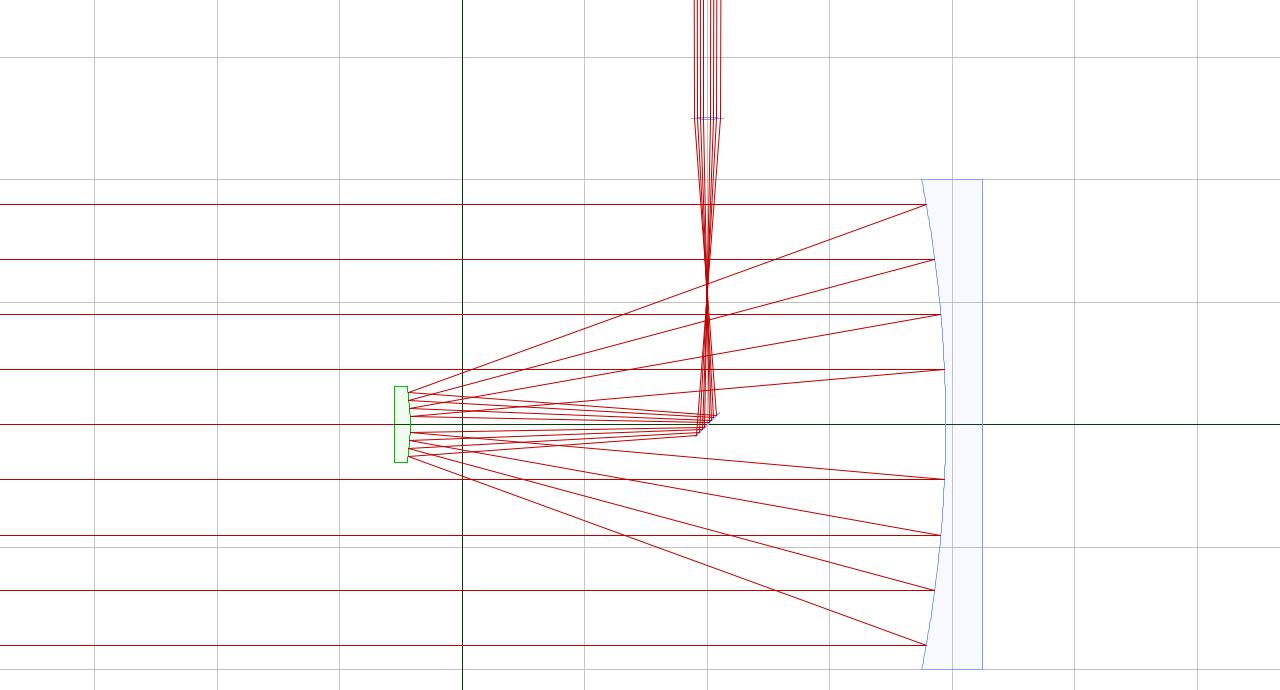Cassegrain Telescope Model

Figure 1: OpticalrayTracer Cassegrain telescope model
(click image for full size)
Click this link to see the OpticalRayTracer technical description for the Cassegrain model.
To copy the Cassegrain telescope technical description into your copy of OpticalRayTracer:
- Click here to display the technical description.
- Type Ctrl+A (Select All).
- Type Ctrl+C (Copy). This places the description on your system clipboard.
- Run OpticalRayTracer.
- Click the "Paste full configuration from clipboard" toolbar button. This will paste the description into OpticalRayTracer, and you should see the configuration shown in Figure 1.
- (The reason for all the keyboard activity is to get around some browser security safeguards.)
Cassegrain Model
I stumbled upon your OpticalRayTracer program, via a Google search, a few days ago, and am very impressed. Within a few hours of installing it, I had a reasonably accurate model of my 6" Celestron SCT (minus corrector plate) and DSLR sensor (based mainly on my own measurements, as Celestron does not publish much in the way of specifications for their scopes).
This model immediately helped me to understand my scope in greater detail, and it also explained why the cheap focal reducer I bought recently, was a (small) waste of money. I found this immensely satisfying, perhaps more so than making my noisy astrophotographs.
Thanks for writing! I'm glad OpticalRayTracer has provided a useful model. I'm guessing the reason Celestron doesn't provide optical specifics is because of competition from cheap knockoff manufacturers who might make copies.
I'm sorry OpticalRayTracer doesn't have a way to perforate a mirror, for the Cassegrain return path through the primary. I haven't thought of a satisfactory way to do that in the pure mathematical model I'm using internally, one described here.
The only way around this problem I have come up with is to apply a workaround and place a diagonal between the two main mirrors, to complete the optical path at a right angle [see Figure 1 on this page]. I know there are real telescopes that use this arrangement, but for a modern Cassegrain like your Celestron, it's just a way to see the full optical path in my program.
On that topic, I'm attaching a quick technical description of a Cassegrain with a diagonal path that can be pasted into OpticalRaytracer. While creating it I read about Cassegrains, and my reference said the primary mirror needs to be parabolic and the secondary needs to be hyperbolic (no corrector plate in a classic Cassegrain), so I decided to see if that was really the best design. As it turned out, it was — the primary really needs to be parabolic, and the secondary needs to be hyperbolic for the best performance. At the system focal point, located at about x = 2, y = 1 in my model, one can zoom in at a high magnification and adjust the secondary mirror's hyperbolic curvature to "tune" the system and see how this affects the quality of the focus.
To load the model into OpticalRayTracer, copy the entire text attached to this message onto your system clipboard, then paste it into OpticalRayTracer using the toolbar's "Paste full configuration" button [Web page readers, see above to get the model].
I'm glad my program is finding practical applications. Again, thanks for writing!
Axicon Lens
does you software include axicon lenses [Wikipedia:Axicon]?
Yes — just specify a hyperbolic lens with a hyperbolic factor of zero [Curvature class: Hyperbolic, Hyperbolic factor:0]):
ORT screen capture of Axicon lens
Then specify the focal length you desire.
The reason this works is explained in this document:
OpticalRayTracer Technical Description
In the section entitled "Hyperbolic lenses" ... "Conic sections", the example in which z = 0 gives an axicon convex characteristic shape for a positive focal length. And for a concave axicon lens, specify a focal length < 0.
I need to calculate a ray path with some parabolic convex lenses and an axicon lense and some mirrors
It seems OpticalRayTracer can produce all these elements.
Thanks!
You're most welcome.
Prism?
Thank you for making OpticalRayTracer available. It's a very useful piece of software which I use every now and then to verify my understanding of raytracing. I was wondering if you could let me know how to incorporate a prism in the optical path ?
Yes — create a lens, select the hyperbolic profile, and set the hyperbolic factor to zero. A resulting one-sided prism looks like this:
See the settings pane below the image? Just use settings similar to those.
If you need a shallower prism, set the lens "sphere radius" to a value greater than two. If you need a symmetrical, two-sided prism, make the "lens" symmetrical so both sides have the same slope. Like this:
Again, notice the settings below the prism image that create this outcome. More complex prism shapes can be had by adjusting each side of the prism separately (i.e. by not using the "symmetrical" setting).
A more complete understanding of this outcome can be had by reading the OpticalRayTracer Technical Description, in particular the "3.2.3 Conic Sections" and "3.2.8 Hyperbolic Model" article sections.


 Share This Page
Share This Page

 Share This Page
Share This Page


 Share This Page
Share This Page